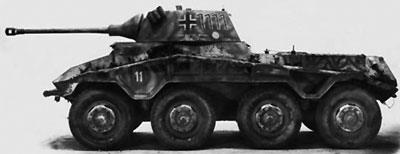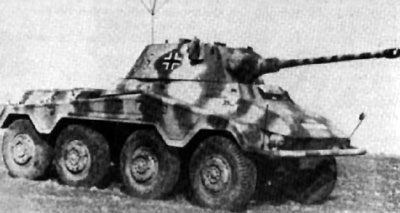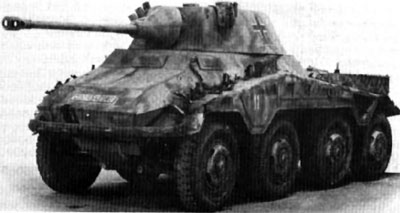with Rich Hamilton
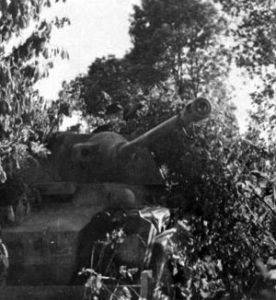
“The best patrols I had were those with clean guns. Even worthwhile targets were only reported and not engaged; that is the business of others. A troop leader with a tendency to bang away is useless for reconnaissance purposes since he is soon located by the enemy and chased like a rabbit. A report giving the location of an enemy tank leaguer is of infinitely more value than five shot-up lorries.”
– Oberst a.D. Fabian von Bonin von Ostau on German armoured reconnaissance tactics
The 234 series of armoured cars was one of the most advanced concepts in wheeled fighting vehicle designs to appear during the war. It had improvements in armour, speed and range. In its original 1940 concept the 234 series was to operate in hot climates. The Czech firm Tatra produced its air-cooled V-12 diesel engine that had an out put of 220hp. The Bussing organization made the hull, which was made of monocoque construction. Daimler-Benz and Schichau were jointly responsible for the turret.
The Puma also addressed the most common complaint among armoured car crewmen; the lack of firepower when forced to engage the enemy. It included the same 50mm KwK L/60 gun carried in the Panzer III Ausf J and L tanks in a cramped enclosed turret with all around traverse. The gun did feature a muzzle break and the vehicle carried 55 rounds for the main gun. The weight of the 50mm gun and turret did result in the loss of some speed for the Puma, but this proved to be insignificant in the vehicles combat performance.
By the time of the Normandy campaign the basic organization of the armoured recon battalion had changed from its original 1939 organization.
Battalion Headquarters
Staff Company (Stabskompanie)
No. 1 Armoured Recon Company (Panzerspahkompanie)
No. 2 Recon Company (Aufklarungskompanie)
No. 3 Recon Company
No. 4 Heavy Company
Supply Company (Versorgungskompanie)
In practice this organization was only theoretical. The Pumas were to make up the Panzerspähkompanie of all Panzer divisions, but by the summer of 1944 there were not enough Pumas to fill the organisational needs of Germany’s Panzer divisions.
The Sd Kfz 234/2 would see action in Normandy in three Panzer divisions. 2. Panzerdivision and Panzer Lehr Panzerdivision were both fully equipped with the “Puma” having a compliment of 26 vehicles. The 2. Panzerdivision’s along with the Panzer Lehr division’s Pumas can be represented with the D-Day: German. First SS Panzer “Liebstandarte Adolf Hitler” also had a number of Puma armoured cars but did not posses a full compliment of them.
The combat techniques of the Puma were to see but not be seen and engage the enemy only when necessary. The radio was its most important weapon for its primary mission. Most of the time the Pumas were organized into three car groups for intelligence gathering missions on enemy movements and locations.
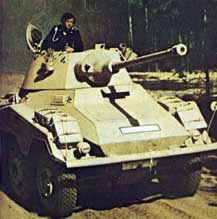
German crews learned important techniques to improve stealth such as easing the vehicles in to gear and running in low gear so they made very little noise. This was opposed to American crewmen who were known for ‘gunning’ their engines and thus giving away their positions to a skilled observer.
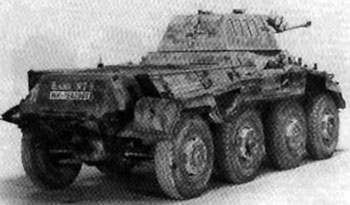
The Pumas first saw combat in Normandy with the Panzer Lehr division’s drive into the invasion zone on 8 June. A few days later on the night of 13 June Pumas of 2nd Panzer Division engaged elements of the US 26th infantry near Caumont which had inconclusive results.

As the Panzer divisions involved in the Normandy campaign were rebuilt in the fall of 1944 the Sd Kfz 234/2 was no longer available in any numbers and was replaced with the more readily available Sd Kfz 234/1 and Sd Kfz 234/3 at that time. With the end of the campaign in Normandy, so too ended the reign of the Puma as the Panzer division’s premiere armoured car.
Sources
Milsom, John and Peter Chamberlain, German Armoured Cars of World War II, Charles Scribner’s Sons, New York: 1974.
Perrett, Bryan, German Armoured Cars and Reconnaissance Half-Tracks 1939 – 1945, Ospresy Publishing, New York: 1999.

